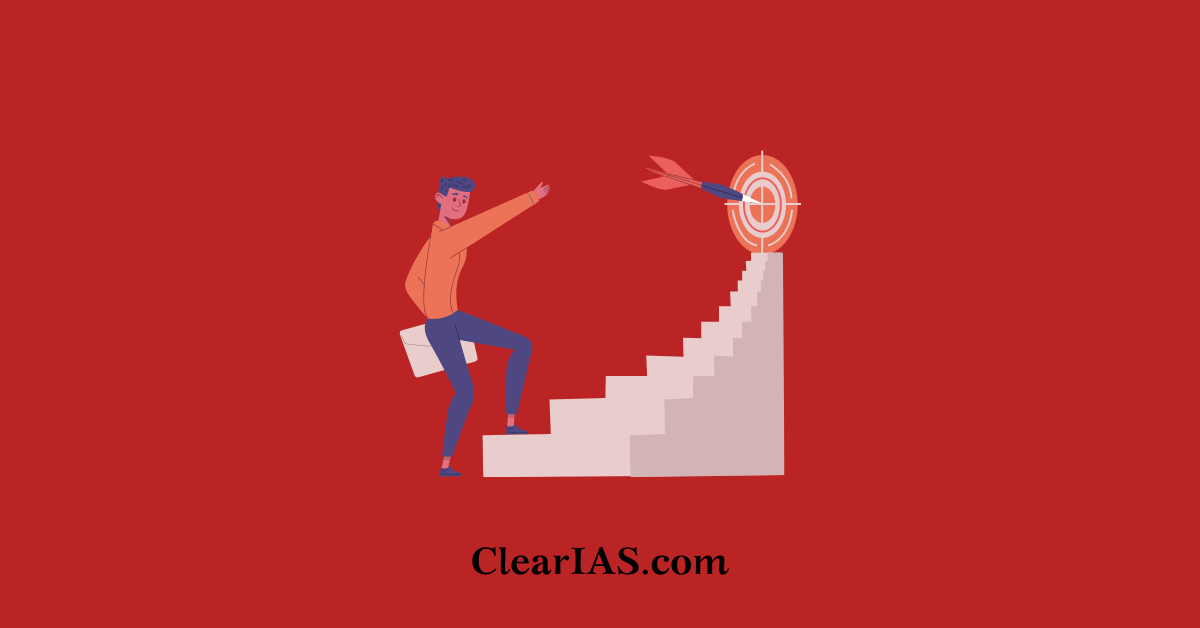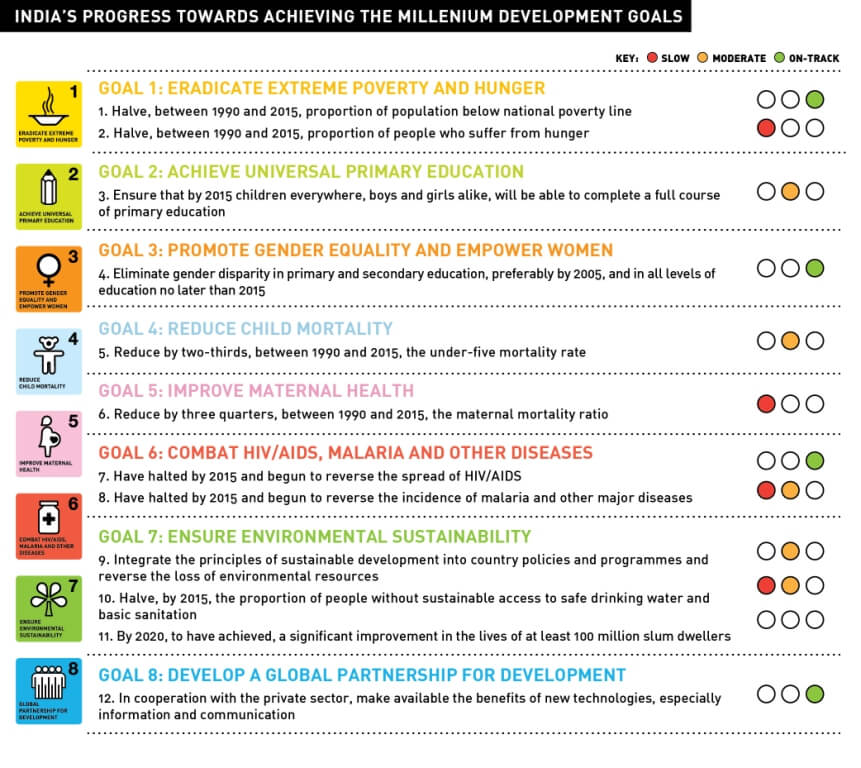 At the United Nations Millennium Summit (Sep 2000), world leaders agreed to eight specific and measurable development goals—later known as the Millennium Development Goals (MDGs). There were 8 MDGs, 18 targets, and 48 indicators to measure the results. The target year was 2015.
At the United Nations Millennium Summit (Sep 2000), world leaders agreed to eight specific and measurable development goals—later known as the Millennium Development Goals (MDGs). There were 8 MDGs, 18 targets, and 48 indicators to measure the results. The target year was 2015.
The Millennium Development Goals (MDGs) were eight international development goals established following the Millennium Summit of the United Nations in 2000.
These goals were designed to address various global challenges, including poverty, hunger, gender equality, education, and healthcare. The MDGs aimed to improve the well-being of people in developing countries and promote sustainable development. The timeline for achieving the goals was set for 2015.
Millennium Development Goals (MDGs)
- Eradicate Extreme Hunger and Poverty
- Achieve Universal Primary Education
- Promote Gender Equality and Empower Women
- Reduce Child Mortality
- Improve Maternal Health
- Combat HIV/AIDS, Malaria and Other Diseases
- Ensure Environmental Sustainability
- Develop a Global Partnership For Development
MDGs – Goals, Targets and Indicators
Goal 1: Eradicate Extreme Hunger and Poverty
Target 1. Halve, between 1990 and 2015, the proportion of people whose income is less than $1 a day
Indicators
1. Proportion of population below $1 (1993 PPP) per day (World Bank)
2. Poverty gap ratio [incidence x depth of poverty] (World Bank)
3. Share of poorest quintile in national consumption (World Bank)
Target 2. Halve, between 1990 and 2015, the proportion of people who suffer from hunger
Indicators
4. Prevalence of underweight children under five years of age (UNICEF-WHO)
5. Proportion of the population below the minimum level of dietary energy consumption (FAO)
Goal 2: Achieve Universal Primary Education
Target 3. Ensure that, by 2015, children everywhere, boys and girls alike, will be able to complete a full course of primary schooling
Indicators
6. Net enrolment ratio in primary education (UNESCO)
7. Proportion of pupils starting grade 1 who reach grade 5 (UNESCO) b*
8. Literacy rate of 15-24 year-olds (UNESCO)
Goal 3: Promote Gender Equality and Empower Women
Target 4. Eliminate gender disparity in primary and secondary education, preferably by 2005, and in all levels of education no later than 2015
Indicators
9. Ratio of girls to boys in primary, secondary and tertiary education (UNESCO)
10. Ratio of literate women to men, 15-24 years old (UNESCO)
11. Share of women in wage employment in the non-agricultural sector (ILO)
12. Proportion of seats held by women in national parliament (IPU
Goal 4: Reduce Child Mortality
Target 5. Reduce by two-thirds, between 1990 and 2015, the under-five mortality rate
Indicators
13. Under-five mortality rate (UNICEF-WHO)
14. Infant mortality rate (UNICEF-WHO)
15. Proportion of 1-year-old children immunized against measles (UNICEF-WHO)
Goal 5: Improve Maternal Health
Target 6. Reduce by three-quarters, between 1990 and 2015, the maternal mortality ratio
Indicators
16. Maternal mortality ratio (UNICEF-WHO)
17. Proportion of births attended by skilled health personnel (UNICEF-WHO)
Goal 6: Combat HIV/AIDS, Malaria and other diseases
Target 7. Have halted by 2015 and begun to reverse the spread of HIV/AIDS
Indicators
18. HIV prevalence among pregnant women aged 15-24 years (UNAIDS-WHO-UNICEF)
19. Condom use rate of the contraceptive prevalence rate (UN Population Division)
19a. Condom use at last high-risk sex (UNICEF-WHO)
19b. Percentage of the population aged 15-24 years with comprehensive correct knowledge of HIV/AIDS (UNICEF-WHO)
19c. Contraceptive prevalence rate (UN Population Division)
20. Ratio of school attendance of orphans to school attendance of non-orphans aged 10-14 years (UNICEF-UNAIDS-WHO)
Target 8. Have halted by 2015 and begun to reverse the incidence of malaria and other major diseases
Indicators
21. Prevalence and death rates associated with malaria (WHO)
22. Proportion of population in malaria-risk areas using effective malaria prevention and treatment measures (UNICEF-WHO) e*
23. Prevalence and death rates associated with tuberculosis (WHO)
24. Proportion of tuberculosis cases detected and cured under DOTS (internationally recommended TB control strategy) (WHO)
Goal 7: Ensure Environmental Sustainability
Target 9. Integrate the principles of sustainable development into country policies and programs and reverse the loss of environmental resources
Indicators
25. Proportion of land area covered by forest (FAO)
26. Ratio of area protected to maintain biological diversity to surface area (UNEP-WCMC)
27. Energy use (kg oil equivalent) per $1 GDP (PPP) (IEA, World Bank)
28. Carbon dioxide emissions per capita (UNFCCC, UNSD) and consumption of ozone-depleting CFCs (ODP tons) (UNEP-Ozone Secretariat)
29. Proportion of population using solid fuels (WHO)
Target 10. Halve, by 2015, the proportion of people without sustainable access to safe drinking water and basic sanitation
Indicators
30. Proportion of population with sustainable access to an improved water source, urban and rural (UNICEF-WHO)
31. Proportion of the population with access to improved sanitation, urban and rural (UNICEF-WHO)
Target 11. Have achieved by 2020 a significant improvement in the lives of at least 100 million slum dwellers
Indicators
32. Proportion of households with access to secure tenure (UN-HABITAT)
Goal 8: Develop a Global Partnership for Development
Target 12. Develop further an open, rule-based, predictable, nondiscriminatory trading and financial system (includes a commitment to good governance, development, and poverty reduction? both nationally and internationally)
Target 13. Address the special needs of the Least Developed Countries (includes tariff- and quota-free access for Least Developed Countries? exports, enhanced program of debt relief for heavily indebted poor countries [HIPCs] and cancellation of official bilateral debt, and more generous official development assistance for countries committed to poverty reduction)
Target 14. Address the special needs of landlocked developing countries and small island developing states (through the Program of Action for the Sustainable Development of Small Island Developing States and 22nd General Assembly provisions)
Target 15. Deal comprehensively with the debt problems of developing countries through national and international measures to make debt sustainable in the long term
Indicators
Official development assistance (ODA)
33. Net ODA, total and to LDCs, as a percentage of OECD/Development Assistance Committee (DAC) donors’ gross national income (GNI)(OECD)
34. Proportion of total bilateral, sector-allocable ODA of OECD/DAC donors to basic social services (basic education, primary health care, nutrition, safe water and sanitation) (OECD)
35. Proportion of bilateral ODA of OECD/DAC donors that is untied (OECD)
36. ODA received in landlocked developing countries as a proportion of their GNIs (OECD)
37. ODA received in small island developing States as a proportion of their GNIs (OECD)
Market access
38. Proportion of total developed country imports (by value and excluding arms) from developing countries and LDCs, admitted free of duty (UNCTAD, WTO, WB)
39. Average tariffs imposed by developed countries on agricultural products textiles and clothing from developing countries (UNCTAD, WTO, WB)
40. Agricultural support estimate for OECD countries as a percentage of their GDP (OECD)
41. Proportion of ODA provided to help build trade capacity (OECD, WTO)
Debt sustainability
42. Total number of countries that have reached their Heavily Indebted Poor Countries Initiative (HIPC) decision points and number that have reached their HIPC completion points (cumulative) (IMF – World Bank)
43. Debt relief committed under the HIPC initiative (IMF-World Bank)
44. Debt service as a percentage of exports of goods and services (IMF-World Bank)
Some of the indicators listed below are monitored separately for the least developed countries, Africa, landlocked developing countries, and small island developing states
Target 16. In cooperation with developing countries, develop and implement strategies for decent and productive work for youth
Indicators
45. Unemployment rate of young people aged 15-24 years, each sex and total (ILO)
Target 17. In cooperation with pharmaceutical companies, provide access to affordable essential drugs in developing countries
Indicators
46. Proportion of population with access to affordable essential drugs on a sustainable basis (WHO)
Target 18. In cooperation with the private sector, make available the benefits of new technologies, especially information and communications technologies
Indicators
47. Telephone lines and cellular subscribers per 100 population (ITU)
48. Personal computers in use per 100 population and Internet users per 100 population (ITU)
Millennium Development Goals – Performance of India







Nicely prepared